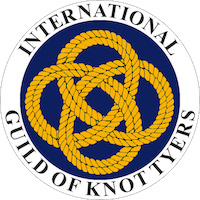Laces – 100s of Ways to Pimp Your Kicks by Ian Fieggen
Sterling Publishing Co. Inc. 2007 ISBN 978-1402752018
New Zealand-born Ian Fieggen (aka ‘Professor Shoelace’), who now lives in Melbourne, Australia, has researched shoelaces for over 30 years. He suggests in this book (his first) that, as they are relatively cheap to replace, readers should customize their footwear with laces that may be natural fibre or synthetic, round or flat, plain, or coloured or plain, hard or soft, stiff or elastic, fat or thin, rough or smooth, long or short. Then [one should] combine two in a single shoe or boot to achieve more complex effects.
The fold-over covers of his book are stitched with the kind of black canvas used for basketball boots, the front one incorporating two parallel sets of six eyelets inserted for the user to practise lacing and tying with the flat lace provided. Inside the back cover is a plastic envelope holding two more flat laces and two round laces. The 192 pages are spiral-bound to lie flat when open, so that each verso (left-hand) page featuring a colour photo of a laced shoe or boot can be viewed with the technical drawing of that lacing and instructions how to do it on the corresponding recto (right-hand) page. Given six pairs of eyelets (or lugs), nearly two trillion (2 x 1012) lacing permutations are theoretically possible, but only a few dozen are practical. This book features 52 of them, portrayed in a range of footwear. Some activities (e.g. running, ball games) require flexibility and adjustable comfort. Others (ice skating, roller blading) need firmer support for insteps and ankles. A few may be protective (motor cycling, horse riding). Ian even gives us a choice of four lacings to facilitate ‘hacky sack’ (the trademarked foot-bag kept aloft by skilful kicking and kneeing).
More decorative variations (say for ceremonial parades) are time consuming, as well as harder to tighten and loosen later. The book also describes 16 knotting methods, including a one-handed tie that could aid arthritic hands. In every instance, a reef – NOT a granny – knot is recommended. And the author’s ‘Ian Knot’ is, he claims, demonstrably ‘the world’s fastest knot’. It could be, as it is a double reef bow tied by the technique for Tom Fool’s knot (A#1141). To complete the main theme, eight ways to make or improvise aglets (those metal or plastic tips on lace ends) are also described.
The book is complemented by a clear and concise list of contents, and a 1,000 word introduction from the author. It ends with four appendices: (1) 86 lacing variations for odd and even numbers of eyelets from three to 12 pairs; (2) algebraic formulae to calculate approximate lengths of lace required for the featured lacing methods, while leaving the required length for knotting; (3) lacing styles listed by attribute – easy, difficult, best with round laces, etc.; (4) knots listed by attribute – easy, difficult, most secure, easiest to untie, etc.. Ian’s final 500 or so words headed Resources commend both the Ashley Book of Knots and the International Guild of Knot Tyers to readers wishing to learn more about knots.
I recommend this robust, handsome product which is an instructive manual, a delightful browse, and a fashion parade of leading shoe brands.
Geoffrey Budworth

